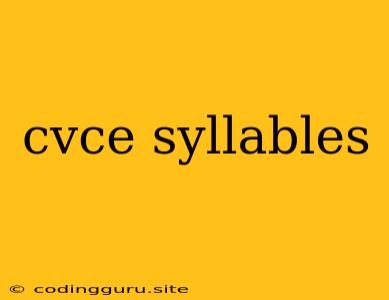What are CVCE Syllables?
CVCE syllables are a fundamental building block in the English language, particularly for young learners. Understanding them is crucial for developing strong reading and spelling skills. But what exactly are CVCE syllables?
CVCE stands for Consonant - Vowel - Consonant - Silent E. This pattern is a key component of many English words, making it essential for decoding and encoding words.
How Do CVCE Syllables Work?
Let's break down the structure of CVCE syllables:
- Consonant (C): The syllable begins with a consonant sound, such as "b," "c," "d," or "f."
- Vowel (V): This is followed by a single vowel sound, like "a," "e," "i," "o," or "u."
- Consonant (C): A consonant sound comes next, forming a closed syllable.
- Silent E (E): The syllable ends with a silent "e." This silent "e" is crucial because it signals that the vowel sound before it is long.
Examples of CVCE Syllables
Let's look at some common words that contain CVCE syllables:
- "take" (t-a-k-e)
- "make" (m-a-k-e)
- "hope" (h-o-p-e)
- "bike" (b-i-k-e)
- "cute" (c-u-t-e)
- "time" (t-i-m-e)
Why Are CVCE Syllables Important?
Understanding CVCE syllables is vital for several reasons:
- Reading: Decoding words with CVCE syllables becomes easier by recognizing the long vowel sound created by the silent "e."
- Spelling: Learning CVCE patterns helps students accurately spell words.
- Phonics: CVCE syllables are a core element of phonics, a method that teaches children to read by connecting sounds and letters.
Tips for Teaching CVCE Syllables
Here are some tips for effectively teaching CVCE syllables:
- Start with simple words: Begin with easy words like "bake," "kite," and "rope" to familiarize students with the pattern.
- Use visuals: Employ flashcards, pictures, and other visual aids to illustrate the sound and spelling of CVCE words.
- Practice with word sorts: Sorting words into categories based on CVCE patterns can strengthen understanding.
- Engage in games: Fun games like "I Spy" or "Bingo" can make learning enjoyable and reinforce the concepts.
- Write and read regularly: Encourage students to write and read words containing CVCE syllables to solidify their skills.
Beyond CVCE Syllables: Expanding Vocabulary
Once students are comfortable with CVCE syllables, they can move on to more complex spelling patterns and word families. Introducing multi-syllable words with CVCE syllables will further enhance reading and spelling comprehension.
Examples of Multi-syllable Words with CVCE Syllables
- "decide" (de-ci-de)
- "believe" (be-lie-ve)
- "complete" (com-ple-te)
- "arrive" (ar-ri-ve)
Conclusion
CVCE syllables are a fundamental element of the English language, providing a solid foundation for reading and spelling. By understanding the structure and patterns of CVCE syllables, students can unlock the world of reading and writing with confidence. Teaching these concepts effectively will equip students with the tools they need to become fluent readers and spellers.
